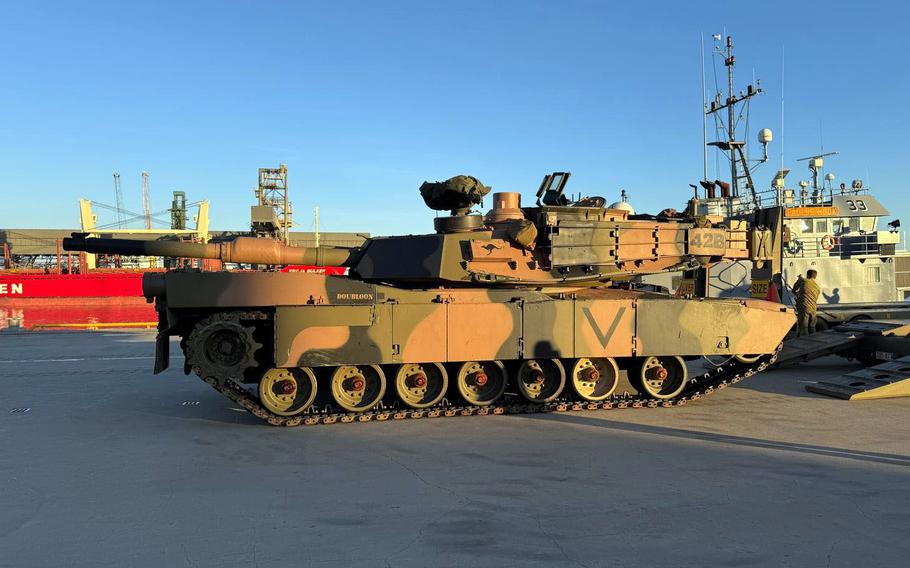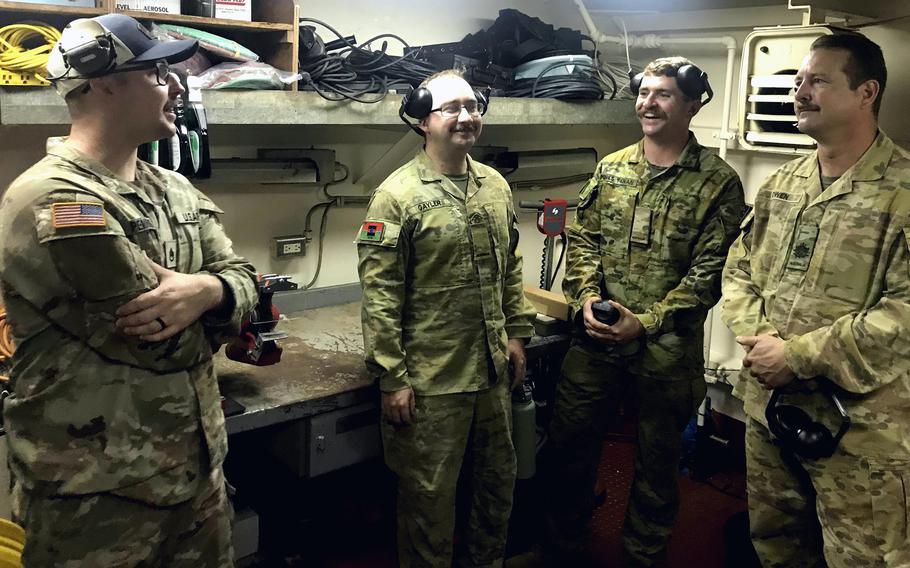
The USAV Paulus Hook, a U.S. Army Runnymede-class landing craft utility, berths in Townsville, Australia on July 18, 2025. (Seth Robson/Stars and Stripes)
TOWNSVILLE, Australia — A U.S. Army vessel that typically operates out of Japan has executed a first-of-its-kind mission in Australia: hauling four M1A1 Abrams main battle tanks for the Australian army as part of ongoing Talisman Sabre drills.
The USAV Paulus Hook is a Runnymede-class landing craft utility that’s 174 feet long and capable of carrying up to five of the 74-ton tanks at once.
On Saturday, the vessel loaded the tanks at Port of Townsville in Queensland and headed south along the coast to drop them off at the Port of Gladstone, south of Rockhampton.
“We are right in the most critical region for this capability,” the vessel’s master, Warrant Officer 1 Chad Arness, told Stars and Stripes on Friday aboard the ship, berthed near commercial freighters and a towering crane.

An Australian army M1A1 Abrams tank prepares to load onto the USAV Paulus Hook, a U.S. Army landing craft utility, in Townsville, Australia, on July 19, 2025. (Adan Cazarez/U.S. Army)
The Paulus Hook is part of the 5th Transportation Company, which was activated in February 2024 at Yokohama North Dock, just south of Tokyo.
The company, which also operates two small tugboats, is making its debut at Talisman Sabre, a biennial exercise and the largest ever conducted by the United States and Australia. This year’s drills, which began July 13 and run through Aug. 4, involve more than 35,000 personnel from 19 countries.
Transporting tanks at sea is not without its challenges. Arness said the additional weight brings the Paulus Hook’s top speed down from 12 knots to 10 but does not compromise its stability. He added that the crew of 14 has encountered little in the way of hazards — no crocodiles yet, despite local warnings, though whales have made appearances in surrounding waters.
A crocodile, rumored to feed on cattle that fall from passing livestock ships, is known to patrol the murky harbor, according to dockworkers.
The Paulus Hook departed Yokohama on June 14, first stopping at Naha, Okinawa, to deliver containers and vehicles, Arness said. From there, it crossed the equator and entered Australian waters at Gladstone, moving supplies north to Shoalwater Training Area before arriving in Townsville on Thursday night.
The ship’s presence is more than just logistical. It also represents a strategic shift in how the U.S. Army envisions littoral operations in the Indo-Pacific.
The transportation company’s commander, Capt. Alena Leshchyk, also in Townsville on Friday, said the service hopes to expand its watercraft fleet in the region, though decisions about basing locations remain under consideration.
For Australian forces, the visit offers a rare up-close look at what the future might hold. On Friday, about two dozen Australian soldiers toured the Paulus Hook, peppering the crew with questions about its tools, spare parts and pneumatic systems.

Australian soldiers quiz U.S. Army mariners about operations aboard the USAV Paulus Hook, a Runnymede-class landing craft utility, in Townsville, Australia, July 18, 2025. (Seth Robson/Stars and Stripes)
Australia’s fleet includes 1960s-era, 72-foot landing craft, which can carry trucks but not battle tanks. That is set to change. The army plans to acquire 18 larger vessels by 2028, significantly improving its littoral capabilities, said Maj. Brenton Chapman, commander of Townsville’s 35 Water Transport Squadron.
“It’s a peek into our future,” he said during the tour.
In the meantime, Australian soldiers have begun preparing for the transition. Some have already trained at Fort Eustis, Va., home to another U.S. Army watercraft unit, Chapman said, and more will join American crews this fall during the Orient Shield exercise in Japan.